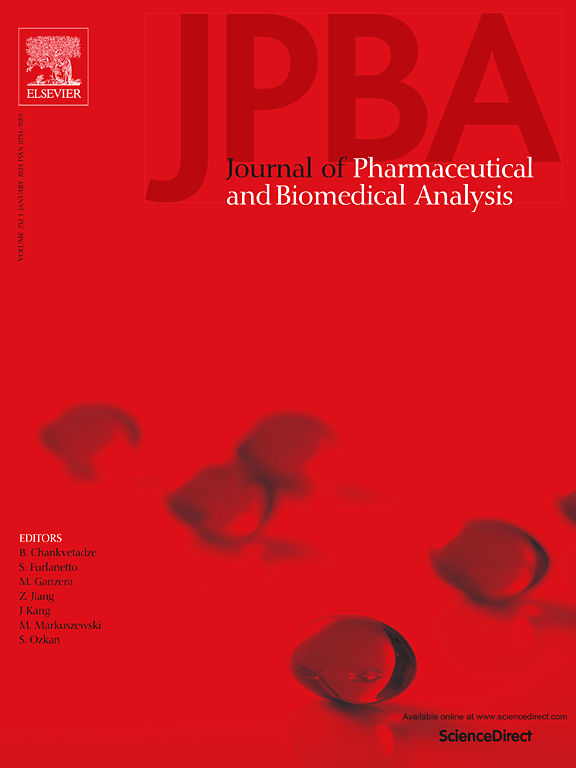GC-MS uncovers unique metabolic markers of drug-resistant epilepsy in capillary but not venous dried blood spots
IF 3.1
3区 医学
Q2 CHEMISTRY, ANALYTICAL
Journal of pharmaceutical and biomedical analysis
Pub Date : 2024-11-04
DOI:10.1016/j.jpba.2024.116561
引用次数: 0
Abstract
This study compared the effectiveness of capillary dried blood spots (DBS) versus venous DBS in detecting metabolic changes related to drug-resistant epilepsy (DRE). DBS samples were collected from 142 epilepsy patients (58 drug-resistant, 84 drug-responsive) via venipuncture or fingerstick capillary sampling. Metabolomic analysis using gas chromatography-mass spectrometry compared DBS metabolite profiles between the two groups. While venous DBS profiles showed no distinct patterns, capillary DBS profiles revealed clustering patterns in principal components analysis, with the first two principal components explaining 14.5 %, and 13.5 % of the total variance, respectively. Orthogonal PLS-DA confirmed group discrimination (R2Y=0.989, Q2=0.742). Drug-resistant patients exhibited elevated capillary DBS levels of glutamine, pyruvic acid, and serine, and decreased palmitic acid compared to drug-responsive patients. Pathway analysis revealed disruptions in amino acid metabolism, neurotransmission, and cellular energy regulation. Elevated glutamine levels may contribute to an imbalance between excitatory glutamate and inhibitory GABA neurotransmission, key factors in epileptogenesis and drug resistance. Capillary DBS, likely enriched with arterial blood supply to the brain, appears to better capture central nervous system metabolic disturbances compared to venous DBS containing systemic contributions. This minimally invasive capillary DBS approach offers effective metabolic profiling of brain conditions like DRE, for monitoring disease progression and treatment response, enhancing personalized patient management in epilepsy.
GC-MS 在毛细血管而非静脉干血斑中发现了耐药性癫痫的独特代谢标记物。
这项研究比较了毛细血管干血斑(DBS)与静脉 DBS 在检测与耐药性癫痫(DRE)相关的代谢变化方面的有效性。研究人员通过静脉穿刺或毛细管指针采样采集了 142 名癫痫患者(58 名耐药患者和 84 名药物反应性患者)的干血细胞样本。利用气相色谱-质谱法进行代谢组学分析,比较了两组患者的 DBS 代谢物谱。静脉 DBS 图谱没有显示出明显的模式,而毛细管 DBS 图谱在主成分分析中显示出聚类模式,前两个主成分分别解释了总方差的 14.5% 和 13.5%。正交 PLS-DA 证实了组别区分(R2Y=0.989,Q2=0.742)。与药物反应患者相比,耐药患者的毛细血管 DBS 中谷氨酰胺、丙酮酸和丝氨酸水平升高,棕榈酸水平降低。通路分析显示,氨基酸代谢、神经传递和细胞能量调节发生了紊乱。谷氨酰胺水平升高可能导致兴奋性谷氨酸和抑制性GABA神经传递失衡,而这正是癫痫发生和耐药性的关键因素。毛细血管 DBS 可能富含大脑动脉供血,与含有全身供血的静脉 DBS 相比,毛细血管 DBS 似乎能更好地捕捉到中枢神经系统的代谢紊乱。这种微创的毛细血管 DBS 方法能有效地分析 DRE 等脑部疾病的代谢情况,用于监测疾病进展和治疗反应,从而加强癫痫患者的个性化管理。
本文章由计算机程序翻译,如有差异,请以英文原文为准。
求助全文
约1分钟内获得全文
求助全文
来源期刊
CiteScore
6.70
自引率
5.90%
发文量
588
审稿时长
37 days
期刊介绍:
This journal is an international medium directed towards the needs of academic, clinical, government and industrial analysis by publishing original research reports and critical reviews on pharmaceutical and biomedical analysis. It covers the interdisciplinary aspects of analysis in the pharmaceutical, biomedical and clinical sciences, including developments in analytical methodology, instrumentation, computation and interpretation. Submissions on novel applications focusing on drug purity and stability studies, pharmacokinetics, therapeutic monitoring, metabolic profiling; drug-related aspects of analytical biochemistry and forensic toxicology; quality assurance in the pharmaceutical industry are also welcome.
Studies from areas of well established and poorly selective methods, such as UV-VIS spectrophotometry (including derivative and multi-wavelength measurements), basic electroanalytical (potentiometric, polarographic and voltammetric) methods, fluorimetry, flow-injection analysis, etc. are accepted for publication in exceptional cases only, if a unique and substantial advantage over presently known systems is demonstrated. The same applies to the assay of simple drug formulations by any kind of methods and the determination of drugs in biological samples based merely on spiked samples. Drug purity/stability studies should contain information on the structure elucidation of the impurities/degradants.

 求助内容:
求助内容: 应助结果提醒方式:
应助结果提醒方式:


